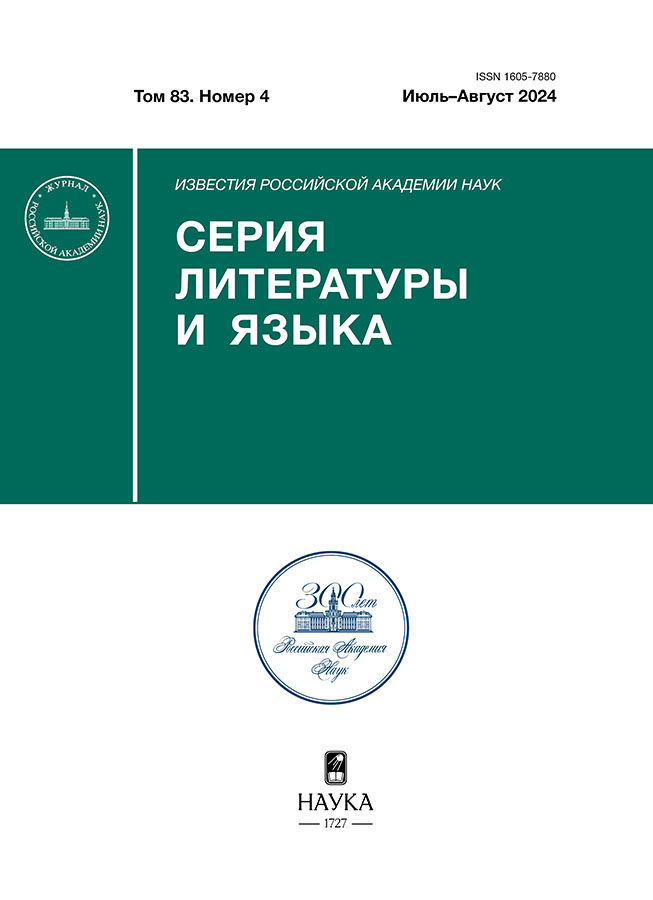Hamlet and Ludi (Commentary on Two Words in Hamlet: Quarto vs Folio)
- Authors: Mikeladze N.E.1
-
Affiliations:
- Lomonosov Moscow State University
- Issue: Vol 83, No 4 (2024)
- Pages: 47-52
- Section: Articles
- URL: https://rjonco.com/1605-7880/article/view/657010
- DOI: https://doi.org/10.31857/S1605788024040056
- ID: 657010
Cite item
Abstract
The texts of the lifetime quartos of Shakespeareʼs Hamlet and the first posthumous folio of 1623 differ significantly. Their analysis and comparisons underlies the researchers’ assumptions and hypotheses about the “authorʼs” manuscripts, “foul papers”, prompt-books, “pirated” editions, the specifics of authorʼs vocabulary, spelling and punctuation, different kinds of emendations: typists’ errors and negligence, “authorʼs” edits, justified and unjustified interventions of editors, etc. But above all they determine our idea of Shakespeareʼs worldview, the laws of life and culture of his time, often relevant today. In modern editions two discrepancies we examined are usually reproduced not from the good quarto of 1604 (Q2, left), but according to the First folio version (F1, right): sanctity – sanitie (II, 2, 207); gamgiuing – gain-giuing (V, 2, 194). Russian translations are also made from it.
A comparative study of the text and the context of these passages led us to the following conclusions. In both cases preference should be given to the “true and perfect” text of the Second quarto (Q2) and proceed from it in reprints and new translations of Hamlet. In scholarly editions of the play both places need detailed commentary, which is important for Shakespearean studies. Gamgiuing requires a correction to gaming with justification of the probable cause of the typo. Both words explain the development of the complex motive of game and gaming in the play, and specifically Hamlet’s attitude towards the game: his penchant for wise play with words and meanings, considered as “madness” by “carnal” men (1Cor 2: 12–15), and his rejection of gambling in the logic of Roger Ascham’s treatise Toxophilus (1545).
Keywords
Full Text
About the authors
N. E. Mikeladze
Lomonosov Moscow State University
Author for correspondence.
Email: fornatalia@bk.ru
Doct. Sci. (Philol.), Professor
Russian Federation, MoscowReferences
- Shakespeare and Textual Studies. Ed. by Margaret J. Kidnie and Sonia Massai. Cambridge; New York: Cambridge University Press, 2015. xiv, 467 p.
- The Arden Research Handbook of Shakespeare and Textual Studies. Ed. Lukas Erne. London: Bloomsbury Publishing, 2021. 408 p.
- Хейзинга Йохан. Homo Ludens. Статьи по истории культуры. / Пер., сост., вступ. ст. Д.В. Сильвестрова; коммент. Д. Э. Харитоновича. М.: Прогресс – Традиция, 1997. 416 с. [Hejzinga, Johan. Homo Ludens. Statji po istorii kultury [Homo Ludens. Articles on Cultural History]. Moscow: Progress – Tradicija Publ., 1997. 416 p. (In Russ.)]
- Shakespeare William. Hamlet. Ed. by Ann Thompson, Neil Taylor. London: Cengage Learning, 2006. 613 p. (The Arden Shakespeare, 3rd ser.)
- Shakespeare William. Hamlet. Ed. John F. Andrews. London: Everyman. J.M. Dent, Vermount: C.E. Tuttle. 1993. lxxiii + 370 p.
- The tragicall historie of Hamlet, Prince of Denmarke. By William Shakespeare. Newly imprinted and enlarged to almost as much againe as it was, according to the true and perfect coppie (Second Quarto). London: printed by I. R. [James Roberts] for N.L. [Nicholas Ling] and are to be sold at his shoppe vnder Saint Dunstons Church in Fleetstreet, 1604. [102] p.
- The Tragicall Historie of Hamlet, Prince of Denmarke. By William Shakespeare. As It hath beene Diuerse Times Acted by His Highnesse Seruants in the Cittie of London: As also in the Two Vniuersities of Cambridge and Oxford, and Else-where (First Quarto). London: Printed [by Valentine Simmes] for N[icholas] L[ing] and Iohn Trundell, 1603. 78 р.
- Shakespeare William. The Tragedie of Hamlet, Prince of Denmarke. The First Folio of Shakespeare. Prepared by C. Hinman. New York; London: W.W. Norton & Company, 1996. Р. 760—790. 928 р.
- Shakespeare William. Hamlet. Ed. Harold Jenkins. London; New York: Methuen, 1982. 574 p. (The Arden Shakespeare, 2nd ser.)
- The Bible: The Holy Scriptures, contained in the Olde and Newe Testament (Geneva Bible 1560–1599 with footnotes). [Электронный ресурс]: https://www.biblegateway.com
- Микеладзе Н.Э. Милосердие сильнее мести. Время и вечность в театре Шекспира. М., СПб.: Центр гуманитарных инициатив, 2019. (Mediaevalia) 624 с. [Mikeladze, N.E. Miloserdie silnee mesti. Vremja i vechnost v teatre Shekspira. [In Virtue than In Vengeance. Time and Eternity in the Theatre of Shakespeare]. Moscow, St. Petersburg: Center for Humanitarian Initiatives Publ., 2019. 624 p. (In Russ.)]
- A Glossary of Tudor and Stuart words. Collected by Walter W. Skeat. Ed. A.L. Mayhew. Oxford: Clarendon Press, 1914. 462 p.
- Oxford English Dictionary (OED) Oxford University Press, 2023. [Электронный ресурс]: https://www.oed.com
- Merriam-Webster Dictionary, 2023. [Электронный ресурс]: https://www.merriam-webster.com
- The tragedy of Hamlet Prince of Denmarke. by VVilliam Shakespeare. At London: Printed for Iohn Smethwicke, and are to be sold at his shoppe in Saint Dunstons Church yeard in Fleetstreet. Vnder the Diall, 1611. [104] p. Folger Digital Image Collection. STC 22277 copy 1, N3v. [Электронный ресурс]: https://luna.folger.edu
- Ascham Roger. Toxophilus, 1545. Ed. by Edward Arber. Westminster: A Constable & Co., 1895. 201 p.
- Микеладзе Н.Э. Слово Горацио, или «Гамлет» как психодрама // Эпох скрещенья. Литературные исследования от Средневековья до Нового времени. Сборник памяти Андрея Николаевича Горбунова. М.: Литфакт, 2023. C. 51–63. (408 с.) [Mikeladze, N.E. Slovo Goracio, ili “Gamlet” kak psihodrama [Horatio’s Word, or Hamlet as Psychodrama]. Jepoh skreshhenja. Literaturnye issledovanija ot Srednevekovja do Novogo vremeni. Sbornik pamjati Andreja Nikolaevicha Gorbunova [Crosses of Time. Studia Litterarum from Middle Ages to Modernity. In Memoriam Andrey Nikolaevich Gorbunov]. Moscow: LitFact Publ., 2023, pp. 51–63. (In Russ.)]
Supplementary files











